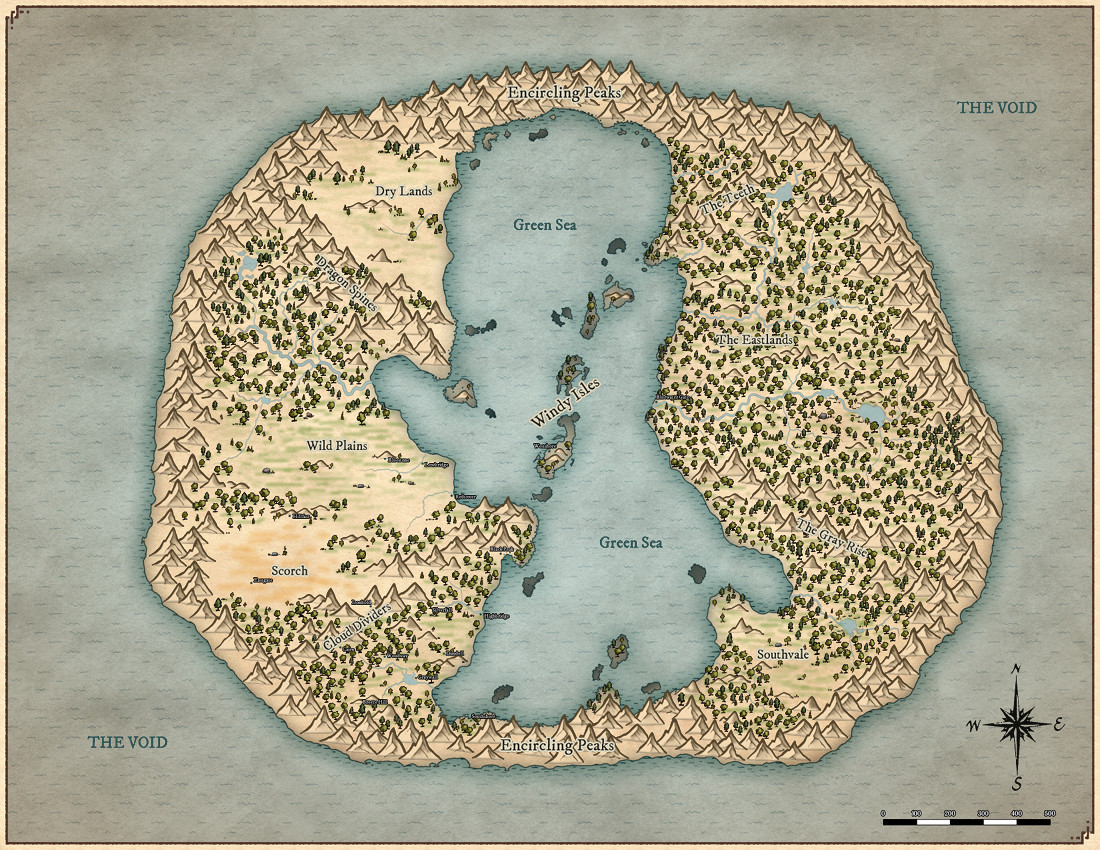Mendia Map

Mendia is a broad, roughly disk-shaped world. Huge mountains border the outer rim, and the warm, shallow Green Sea divides the world into eastern and western halves. The Windy Isles cross the sea from the southwest to the northeast, like stepping stones. They are mainly populated by Elves and Humans. The Eastlands are heavily forested and home to many Elves. Parts of the Eastlands never fell under the sway of the Outsiders or Glaudrim and here the World Tree's wounds are barely perceptible.
The western continent is divided into thirds by two mountain ranges that split off the Encircling Peaks. The Dragon Spines run from the northern rim to the coast, surrounding the northeastern quadrant of the continent, the Dry Lands. It is here the Glaudrim first appeared, and both the Dragon Spires and the Dry Lands remain desolate and wild. They are home to Trolls, Kobolds, Walking Corpses, and worse.
A second mountain range. the Cloud Dividers run from southwest reach of the Encircling Peaks to the shores of the Green Sea. The lands south and east of the Dividers are a mix of forest and open plains and home to most of Mendia's human population. Many Dwarves inhabit the rocky slopes of the Dividers and, for the most part, live in peace with their Human neighbors.
The land north of the Dividers and south of the Dragon Spines, the Wild Plains, is mostly rolling hills and prairie. spotted here and there by sparse woodlands. The lands nearest the Dividers are inhabited The further west one travels, the drier the climate. Eastgate and the ruins of Hismir lie on the western edge of the Scorch, a desolate, rocky desert west of the Cloud Dividers and the Wild Plains.
The following measures of time are common on Mendia.
Mendia has a temperate climate with moderate seasonal variation. Average temperatures are highest in the southwest, coolest in the northeast. Spring is generally warm and rainy, particularly along the coasts of the Green Sea. Hot and dry weather is typical in summer, but occasional severe storms bring flash floods, tornadoes, and hail. Autumn is cool and dry, and early snows in the northeast are not uncommon. The relatively short winter brings snow to most parts of Mendia.
Three main features define Mendia's night sky.
The Great Wheel is a band of golden light shot through with twisting streamers of green that crosses Mendia's sky from north to south. It is the primary source of illumination for the realm. The light it produces varies over two time periods, with changing ripples of intensity traveling from north to south (Source to Fall).
Conjunctions occur when the Great Wheel aligns with the Lesser Wheel. Discordant Conjunctions happen when the two Wheels spin in opposite directions, Harmonious occur when they spin in the same direction.
Every 24 hours the Great Wheel turns through a 12 hours of light, 12 hours of dark cycle, creating the day-night cycle.
A slow secondary pulse travels through the twisting streamers of green light (the Roots), which go from nearly transparent to clearly visible and back on a 14-day Cycle.
The Lesser Wheel is a filmy band of blue filaments that wobble across the sky and turn in a slow cycle of 42 days, the Mendian month. The month begins when the Three Eyes, a cluster of bright reddish points caught within the web of the Lesser Wheel, rise.
The Three Eyes rise on the first of the month, reach the top of the Lesser Wheel on the evening of the 10th, and set on the 21st. They are hidden for the remainder of the month.
The ends of the Lesser Wheel rotate through the points of the compass, completing a cycle every 181 days. As mentioned, conjunctions occur when it aligns with the Great Wheel. Discordant Conjunctions happen when the two Wheels spin in opposite directions, Harmonious occur when they spin in the same direction. The Lesser Wheel also passes in front of the Heart of the Tree, dimming its light. Days when this happens are Veiled. Red Veils occur when the Three Eyes align with the Heart of the Tree, tainting its light. Grovekeepers close their businesses and remain indoors on Red Veil days.
Red Wardens believe the largest of the Three Eyes is Skystone, and hold their monthly services at dusk on the 10th day of each month.
The Heart of the Tree is a stationary feature in the sky of Mendia, a disk of pale green light with many radiating tendrils. It is located about 45 degrees west of the Great Wheel and 65 degrees south of west.
The illumination provided by the Heart of the tree is dim, but it generates warmth and energy that feeds the plant life of Mendia.
The energy provided by the Heart varies over a cycle of 378, the Mendian year. It also determines the ebb and flow of the seasons.